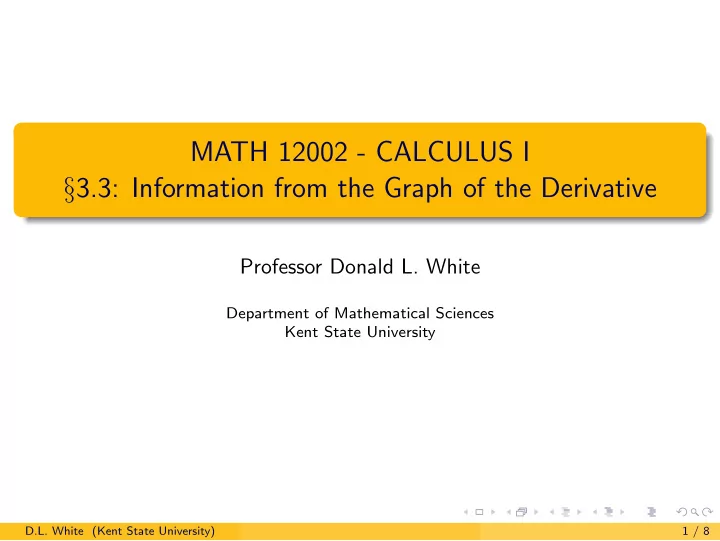

MATH 12002 - CALCULUS I § 3.3: Information from the Graph of the Derivative Professor Donald L. White Department of Mathematical Sciences Kent State University D.L. White (Kent State University) 1 / 8
Summary of Information from the Derivative We have previously derived the following relationships between a function f and its first and second derivatives f ′ and f ′′ : f ′ positive f increasing ← → f ′ negative f decreasing ← → f ′ = 0 or DNE & f local max/min ← → changes sign f ′ increasing f ′′ positive f concave up ↔ ↔ f ′ decreasing f ′′ negative f concave down ↔ ↔ f ′ max/min f ′′ = 0 or DNE & f inflection point ↔ ↔ changes sign In particular, this shows that if we have the graph of f ′ , we can easily determine where f is increasing or decreasing, concave up or concave down, and find x -coordinates of local maxima and minima and inflection points. D.L. White (Kent State University) 2 / 8
Example 1 The graph of the DERIVATIVE f ′ of a function f is given below. Determine intervals where f is increasing and intervals where f is decreasing, the x -coordinates of all local maxima and minima, intervals where f is concave up and intervals where f is concave down, the x -coordinates of all inflection points. D.L. White (Kent State University) 3 / 8
Example 1 To determine increasing/decreasing and local maxima/minima, we use the sign of f ′ : f ′ is positive where its graph is above the x -axis, on ( − 5 , 1) ∪ (5 , 6); f ′ is negative where its graph is below the x -axis, on (1 , 5); f ′ is zero where its graph crosses the x -axis, at x = 1 and x = 5. Therefore, f is increasing on ( − 5 , 1) ∪ (5 , 6) and f is decreasing on (1 , 5). The critical numbers of f are x = 1 and x = 5. At x = 1, f changes from increasing to decreasing, so f has a local maximum at x = 1. At x = 5, f changes from decreasing to increasing, so f has a local minimum at x = 5. D.L. White (Kent State University) 4 / 8
Example 1 To determine concavity and inflection points, we use the sign of the second derivative, which is determined by whether f ′ is increasing or decreasing : f ′ is increasing on ( − 5 , − 3) ∪ (4 , 6); f ′ is decreasing on ( − 3 , 4). Therefore, f is concave up on ( − 5 , − 3) ∪ (4 , 6) and f is concave down on ( − 3 , 4). At x = − 3 and x = 4, f ′ has local extrema and f ′′ = 0. At both points, f changes concavity, so f has inflection points at x = − 3 and x = 4. D.L. White (Kent State University) 5 / 8
Example 2 The graph of the DERIVATIVE f ′ of a function f is given below. Determine intervals where f is increasing and intervals where f is decreasing, the x -coordinates of all local maxima and minima, intervals where f is concave up and intervals where f is concave down, the x -coordinates of all inflection points. D.L. White (Kent State University) 6 / 8
Example 2 f ′ is positive on ( − 4 , 1) ∪ (1 , 5); f ′ is negative on ( − 5 , − 4) ∪ (5 , 6); f ′ is zero at x = − 4, x = 1, and x = 5 — the critical numbers of f . Therefore, f is increasing on ( − 4 , 1) ∪ (1 , 5) and decreasing on ( − 5 , − 4) ∪ (5 , 6). At x = − 4, f changes from decreasing to increasing, so f has a local minimum at x = − 4. At x = 5, f changes from increasing to decreasing, so f has a local maximum at x = 5. At x = 1, f ′ does not change sign and f has no local extremum. D.L. White (Kent State University) 7 / 8
Example 2 f ′ is increasing on ( − 5 , − 2) ∪ (1 , 3); f ′ is decreasing on ( − 2 , 1) ∪ (3 , 6). Therefore, f is concave up on ( − 5 , − 2) ∪ (1 , 3) and f is concave down on ( − 2 , 1) ∪ (3 , 6). At x = − 2, x = 1, and x = 3, f ′ has local extrema and f ′′ = 0. At all three points, f changes concavity, so f has inflection points at x = − 2, x = 1, and x = 3. D.L. White (Kent State University) 8 / 8
Recommend
More recommend